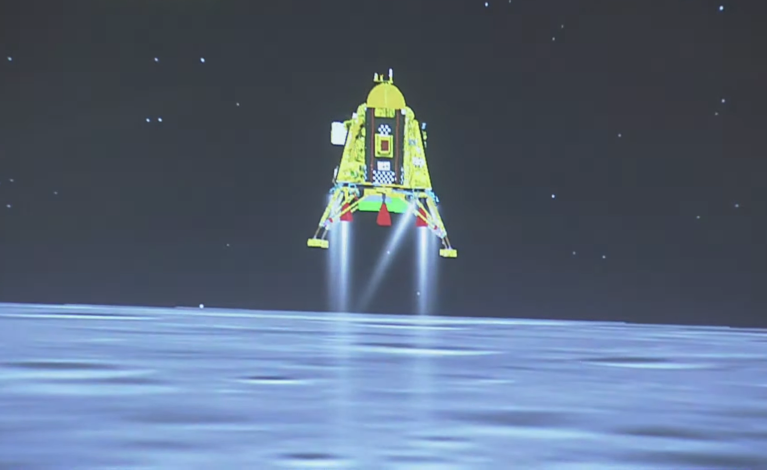
An animated image of Chandrayaan-3's lander projected at the ISRO headquarters shortly before it touched down on lunar soil. Credit: ISRO
India has become the first nation to reach the south pole of the Moon after its Chandrayaan-3 probe successfully landed as planned.
The landing comes just days after Russia’s Luna-25, destined for the same region, crashed on the lunar surface.
India's Prime Minister Narendra Modi congratulated scientists at the Indian Space Research Organisation (ISRO) via a video conference and said the historic mission will help all countries, including those in the global south, "to aspire for the Moon".
The rover Pragyan will shortly roll out of the lander Vikram, ISRO sources said.
Chandrayaan-3 will perform a raft of experiments, including a spectrometer analysis of the mineral and chemical composition of the Moon's surface, returning valuable data on the properties of lunar soil and rocks. It hopes to confirm the presence of water ice in the region, which could supply oxygen, fuel, and drinking water for future space exploration.
Mylswamy Annadurai, director of Chadrayaan-1, India's first Moon mission, told Nature India that the soft landing of Chandrayaan-3 mission will open many opportunities. “This will consolidate India’s position in the future international lunar missions, including that of Artemis.”
Scott Hubbard, former NASA Ames Center director, now with Stanford University, said safely landing a spacecraft on another world is an outstanding scientific and engineering achievement. “With the successful landing of Chandrayaan-3, India has joined a very exclusive club.”
The journey
The voyage by Indian Space Research Organisation (ISRO) started on July 14. Launch vehicle LVM-3 sent Chandrayaan-3 on a 384,000km journey from the Satish Dhawan Space Centre in Sriharikota on India’s southeast coast.
Chandrayaan-3 orbited Earth several times to gain speed before embarking on its month-long lunar trajectory. Three successive orbit reduction manoeuvres on August 6, 9, and 14 moved the spacecraft closer to the Moon. The final manoeuvre on August 16 placed Chandrayaan-3 into an orbit of 153km x 163km, inching it closer to its final landing.
On August 17, the lander separated from the propulsion module on August 17, and slowed to place itself in an orbit where the Perilune (orbit’s closest point to the Moon) was 30 km and Apolune (farthest point from the Moon) was 100 km.
India’s first Moon mission had discovered water molecules on the lunar surface. The second mission Chandrayaan-2 in 2019 crashed during the crucial touchdown.
The science
Chandrayaan-3 comprises an Indian-built lander module (LM), propulsion module (PM) and a rover. The mission goal is to develop and demonstrate new technologies for inter-planetary missions.
The Vikram lander carries an instrument called Chandra’s Surface Thermophysical Experiment (ChaSTE) to measure surface thermal properties, an Instrument for Lunar Seismic Activity (ILSA) to measure seismicity around the landing site, the Radio Anatomy of Moon Bound Hypersensitive ionosphere and Atmosphere (RAMBHA) to study the gas and plasma environment, and a passive laser retroreflector array provided by NASA for lunar ranging studies.
The rover Pragyan (Sanskrit for ‘wisdom’) is to carry out a chemical analysis of the lunar surface in situ as it moves about in the highlands near the Moon’s south pole. The six-wheeled rover will conduct experiments here for one lunar day, equivalent to 14 Earth days.
The rover has two instruments to study the local surface elemental composition — an Alpha Particle X ray Spectrometer(APXS) and a Laser Induced Breakdown Spectroscope(LIBS).
Amitabha Ghosh, a contributor to NASA’s Rover mission to Mars, and a part of the Mars Pathfinder mission team, told Nature India that while the feat will be remembered as a “golden day in the history of Indian space exploration,” scientists were keenly “looking forward to the science investigation that the rover will embark on in the coming days and also the new knowledge about the south pole.”
After Chandrayaan-2’s failure, the focus was on the crucial landing, which entailed extensive simulations. The lander was equipped with stronger landing legs, more propellant and improved sensors. The software was changed and the landing area was expanded.
There have been several challenges in building the two instruments that are being carried by Pragyan.
“The main challenge was to indigenously design the electronics such that the excellent energy resolution provided by the state-of-the-art Silicon Drift Detector (SDD), the X-ray detector used in APXS, is not degraded,” principal investigator Santosh Vadawale, an astrophysicist at the Physical Research Laboratory, Ahmedabad, told Nature India.
APXS uses Cm-244 radioactive sources to excite elements on the lunar surface. “Obtaining these sources and handling them throughout the development cycle and various phases of testing was a major challenge because of the radiation safety aspects,” said Vadawale.
